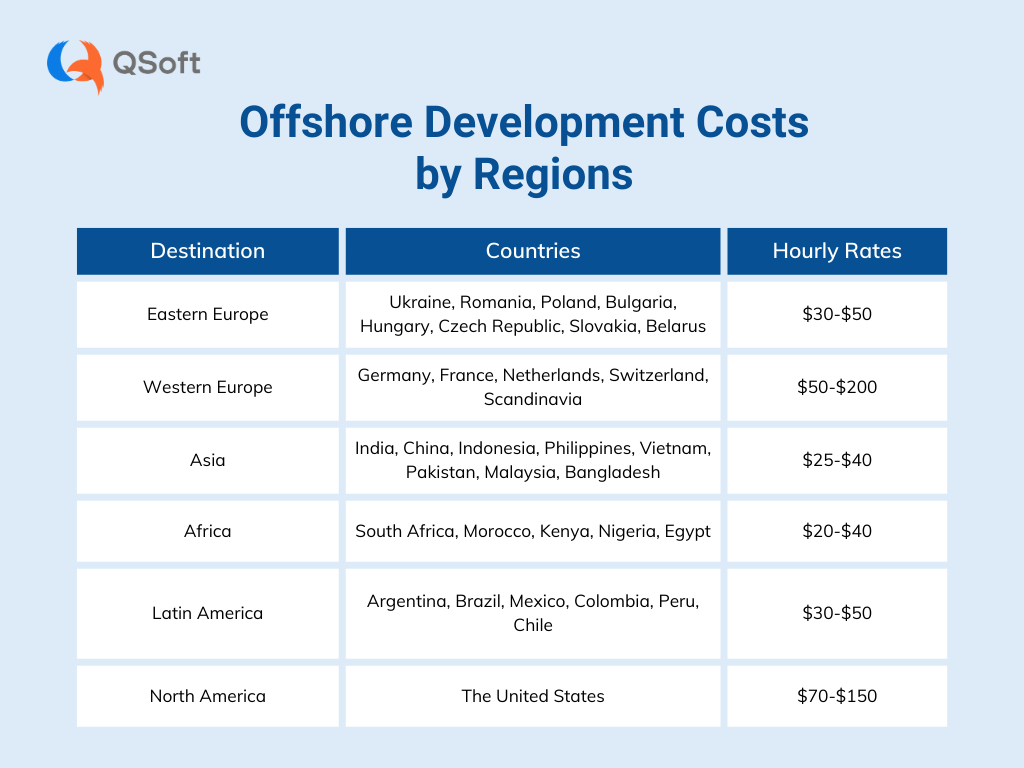How to Estimate Software Development Costs for APAC Clients
Accurately estimating the cost of outsource custom software development projects is critical for ensuring project success and client satisfaction. In this blog, we will explore how to accurately estimate the cost of software development projects for APAC clients, providing valuable insights and practical tips to help you navigate this complex process.
1. Introduction
Cost estimation is a critical aspect of software development, especially for businesses operating in the APAC region. Effective software project cost management ensures that projects are completed within budget, timelines are met, and resources are efficiently utilized. This blog provides an in-depth understanding of software development cost estimation and offers practical steps and best practices to accurately estimate costs for software development projects.
2. Understanding Cost Estimation in Software Development
Definition and Importance:
Cost estimation in software development is the process of predicting the financial resources required to complete a project within a defined scope and timeframe. It encompasses all potential expenses, including labor, technology, materials, and overheads. Accurate cost estimation is crucial because it enables effective software development budget planning, mitigates financial risks, builds client trust, assesses project feasibility, optimizes resource use, and provides a competitive advantage by ensuring projects are completed on time and within budget.
Key Components Influencing the Cost
Estimating software development expenses accurately requires a comprehensive understanding of the project scope and requirements. Custom software project pricing can vary widely based on factors such as complexity, technology stack, and regional labor costs. Understanding these components helps in creating more precise and comprehensive cost estimates.
Project Scope and Complexity:
-
- Requirements: Detailed and well-defined requirements can reduce ambiguity, leading to more accurate estimates. For example, a project requiring integration with multiple third-party APIs will be more complex and costly than one with standalone functionality.
- Features and Functionalities: The number and complexity of features directly impact the cost. For instance, a simple e-commerce site with basic shopping cart functionality will cost less than a comprehensive platform with real-time inventory management, advanced analytics, and personalized user recommendations.
- Customization: Custom software development typically involves more complexity and higher costs compared to off-the-shelf solutions due to the need for tailored functionalities. For example, a custom CRM system designed to meet specific business processes will cost more than a generic CRM solution.
Technology Stack:
-
- Programming Languages and Frameworks: Some technologies are more expensive to implement due to licensing fees, development tools, or the need for specialized skills. For example, developing a mobile app using Swift for iOS and Kotlin for Android can be more costly than using a cross-platform framework like Flutter or React Native.
- Integration Requirements: Integrating new software with existing systems or third-party services can add to the complexity and cost. For example, a new HR system that needs to integrate with existing payroll, attendance, and benefits systems will require additional development and testing effort.
Team Composition:
-
- Roles and Expertise: The cost of a project is influenced by the number of team members and their expertise. Senior developers, architects, and project managers typically command higher salaries.
-
- Geographical Location: Offshore software development costs are significantly influenced by the location of the development team. Outsourcing custom software development to skilled professionals in the APAC region can offer cost advantages due to lower labor rates. For example, hiring developers in Vietnam or India can be more cost-effective compared to hiring in the US or Western Europe.

Timeline and Deadlines:
-
- Project Duration: Longer projects can incur higher costs due to prolonged use of resources and potential for increased overheads. For example, a project estimated to take six months will generally be less expensive than a project extending over two years due to ongoing resource allocation.
- Urgency: Tight deadlines may require additional resources or overtime work, increasing the overall cost. For example, if a project needs to be completed in three months instead of the planned six months, additional developers may need to be hired or current staff may need to work overtime, both of which increase costs.
3. Regional Considerations for APAC Clients
When estimating the cost of software development projects for clients in the APAC (Asia-Pacific) region, it is crucial to understand and factor in regional considerations. The APAC region is diverse, encompassing countries with varying economic conditions, labor markets, cultural practices, and business environments. This section delves into the specific regional factors that can influence cost estimation.
Currency Fluctuations:
-
- Impact: Currency exchange rates can significantly impact project costs, especially when dealing with multiple currencies. Fluctuations can either increase or decrease the cost of labor and materials.
- Example: A project outsourced to a country with a weaker currency compared to the client’s currency might initially seem cost-effective. However, if the local currency strengthens, the project cost can rise unexpectedly.
Economic Stability:
-
- Impact: The economic stability of a country affects labor costs, inflation rates, and the availability of skilled professionals.
- Example: Countries with stable economies like Japan and Singapore might have higher labor costs but offer a reliable workforce and stable project timelines. In contrast, emerging economies might offer lower costs but could face economic volatility.
Availability of Skilled Workforce:
-
- Impact: The availability and expertise of skilled professionals in the region influence project costs. Areas with a high concentration of tech talent can provide more competitive rates.
- Example: India and Vietnam have large pools of highly skilled developers, often at lower rates than their Western counterparts, making them attractive destinations for outsourcing custom software development.
Labor Costs:
-
- Impact: Labor costs vary significantly across the APAC region. Understanding these differences is key to accurate cost estimation.
- Example: Labor costs in Australia and Japan are relatively high compared to countries like the Philippines and Indonesia. This discrepancy can affect the overall project budget substantially.
Communication Styles:
-
- Impact: Effective communication is crucial for project success. Different cultural approaches to communication can influence project management and timelines.
- Example: In some APAC countries, indirect communication is common, which might lead to misunderstandings if not managed properly. Ensuring clear and direct communication channels can mitigate such risks.
Work Ethic and Practices:
-
- Impact: Regional work ethics and practices, such as attitudes towards deadlines, work hours, and hierarchical structures, can affect project progress and costs.
- Example: Japanese companies often emphasize meticulous planning and quality, which might extend project timelines but result in higher quality outputs. On the other hand, countries with a more flexible work approach might offer faster turnaround times but may require more rigorous quality checks.
Intellectual Property Laws:
-
- Impact: Understanding the intellectual property (IP) laws in the region is essential to protect the client’s interests and ensure compliance.
- Example: Countries like Singapore have stringent IP laws, providing strong protection for software and technology innovations. This security might justify higher costs due to the legal framework ensuring IP protection.
Data Protection Regulations:
-
- Impact: Compliance with local data protection and privacy regulations is crucial, especially for projects involving sensitive information.
- Example: The General Data Protection Regulation (GDPR) in Europe has counterparts in APAC, such as the Personal Data Protection Act (PDPA) in Singapore. Ensuring compliance might require additional resources and costs.
Technology Infrastructure:
-
- Impact: The quality of a country’s technology infrastructure, including internet connectivity, data centers, and software development tools, can influence project efficiency and costs.
- Example: Countries with advanced technological infrastructure like South Korea can support more complex projects efficiently, whereas regions with less developed infrastructure might face delays and increased costs.
Adoption of Emerging Technologies:
-
- Impact: The adoption rate of emerging technologies like AI, IoT, and blockchain varies across the APAC region, affecting the availability of expertise and the cost of implementation.
- Example: Regions like Hong Kong and Singapore, with high adoption rates of emerging technologies, can offer advanced solutions but at a higher cost due to the specialized skills required.
4. Steps to Accurately Estimate Costs
Initial Consultation and Requirement Gathering
Importance: The initial consultation and requirement gathering phase is critical as it lays the foundation for the entire project. This phase involves engaging with the client to understand their needs, goals, and expectations.
Steps:
- Client Interviews: Conduct detailed interviews with stakeholders to gather comprehensive information about the project requirements.
- Documentation Review: Review any existing documentation, such as business plans, user stories, and technical specifications.
- Requirement Analysis: Analyze the requirements to identify key functionalities, user roles, and system interactions.
- Scope Definition: Clearly define the project scope, including deliverables, milestones, and boundaries.
Example: For a project aimed at developing a custom CRM system, this phase would involve understanding the client’s sales processes, customer interaction points, and desired features such as lead management, analytics, and integration with existing tools.
Work Breakdown Structure (WBS)
Importance: A Work Breakdown Structure (WBS) breaks down the project into smaller, more manageable components. This helps in identifying all the tasks that need to be completed and provides a clear roadmap for the project.
Steps:
- Identify Major Deliverables: List the major deliverables or phases of the project.
- Break Down Deliverables: Decompose each deliverable into smaller tasks and subtasks.
- Assign Responsibilities: Assign each task to a specific team member or team.
- Sequence Tasks: Arrange tasks in a logical sequence and identify dependencies.
Example: For a mobile app development project, the WBS might include phases like UI/UX design, frontend development, backend development, integration, testing, and deployment. Each phase would be broken down into specific tasks, such as designing wireframes, developing login functionality, setting up databases, and conducting user acceptance testing.
Effort Estimation Techniques
Importance: Utilizing accurate cost estimation techniques can significantly improve the reliability of project budgets. Effort estimation is crucial for determining the amount of work required to complete each task. This helps in calculating the total time and resources needed for the project.
Techniques:
- Expert Judgment: Rely on the expertise of experienced team members to estimate effort based on similar past projects.
- Analogy-Based Estimation: Compare the current project with similar completed projects and use their data to estimate effort.
- Parametric Estimation: Use mathematical models to estimate effort based on project parameters, such as the number of features or lines of code.
- Three-Point Estimation: Calculate effort by considering optimistic, pessimistic, and most likely scenarios.
Example: For a web application project, effort estimation might involve experts estimating the time required for tasks like setting up the server, developing core functionalities, creating a responsive design, and integrating third-party APIs. Parametric estimation could use metrics like “hours per feature” based on past data.
Resource Planning
Importance: Resource planning ensures that all necessary resources, including personnel, tools, and infrastructure, are available and allocated efficiently. Proper resource planning helps in avoiding delays and cost overruns.
Steps:
- Identify Resources: List all the resources required for the project, including developers, designers, project managers, tools, and infrastructure.
- Resource Allocation: Allocate resources based on their availability and expertise. Ensure that critical tasks have the necessary resources.
- Schedule Resources: Develop a resource schedule to manage the timing and duration of resource usage.
- Monitor and Adjust: Continuously monitor resource utilization and make adjustments as needed to address any shortages or over-allocations.
Example: In a software development project, resource planning might involve assigning a senior developer to oversee the architecture design, allocating frontend and backend developers to specific modules, scheduling QA engineers for different testing phases, and ensuring necessary tools like development environments and testing platforms are available.
Risk Assessment
Importance: Risk assessment helps in identifying potential risks that could impact the project’s timeline and budget. By anticipating risks, you can develop strategies to mitigate them, ensuring smoother project execution.
Steps:
- Identify Risks: List potential risks that could affect the project, such as technical challenges, resource constraints, or changes in client requirements.
- Analyze Risks: Assess the likelihood and impact of each risk on the project.
- Develop Mitigation Plans: Create strategies to mitigate identified risks, such as contingency plans, alternative solutions, or additional resources.
- Monitor Risks: Continuously monitor risks throughout the project lifecycle and update mitigation plans as needed.
Example: For a cloud-based software development project, potential risks might include data security breaches, integration issues with existing systems, and unexpected changes in technology. Mitigation plans could involve implementing robust security measures, conducting thorough integration testing, and staying updated with the latest technological advancements.
Conclusion
Accurately estimating the cost of software development projects is essential for ensuring project success and client satisfaction, especially in the diverse and dynamic APAC region. Understanding the intricacies of cost estimation—from defining its importance to analyzing key influencing components like project scope, technology stack, team composition, and timelines—provides a solid foundation for effective project planning and execution.
By incorporating regional considerations unique to the APAC market, such as economic factors, labor market conditions, cultural practices, legal regulations, and technological infrastructure, businesses can tailor their cost estimation strategies to better align with local realities. This not only enhances the accuracy of estimates but also fosters smoother project execution and stronger client relationships.
Following a structured approach to cost estimation, including thorough initial consultations, detailed requirement gathering, creating a comprehensive work breakdown structure, employing robust effort estimation techniques, meticulous resource planning, and proactive risk assessment, ensures that projects are well-managed and deliver value within budget and on schedule.
At QSoft, our expertise in custom software development services and deep understanding of the APAC region enable us to provide precise cost estimations and high-quality solutions tailored to our clients’ needs. By leveraging these insights and best practices, businesses can achieve successful project outcomes and maintain a competitive edge in the fast-evolving software development landscape.
For more information or to discuss your software development needs, contact QSoft today and let us help you navigate the complexities of software development cost estimation and project management.

